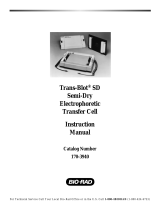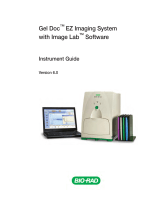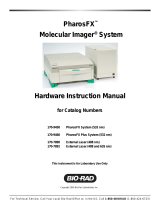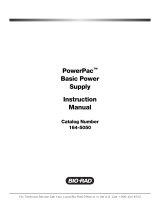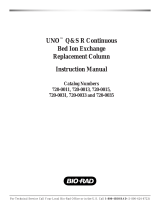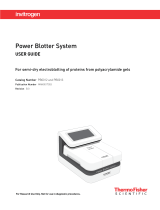
Trans-Blot
®
Turbo
™
Blotting System
Instruction Manual
Catalog number
170-4155


Bio-Rad Technical Support
For help and technical advice, please contact the Bio-Rad Technical Support department. In the United States, the Technical
Support department is open Monday–Friday, 5:00 am–5:00 pm, Pacific Time.
Phone: 1-800-424-6723
Fax: 1-510-741-5802
Email: [email protected] (for U.S. and international customers)
Online technical support and worldwide contact information are available at www.consult.bio-rad.com.
Legal Notices
No part of this publication may be reproduced or transmitted in any form or by any means, electronic or mechanical, including
photocopy, recording, or any information storage or retrieval system, without permission in writing from Bio-Rad Laboratories.
Bio-Rad reserves the right to modify its products and services at any time. This user guide is subject to change without notice.
Although prepared to ensure accuracy, Bio-Rad assumes no liability for errors, or for any damage resulting from the application
or use of this information.
Tween is a trademark of ICI Americas, Inc.
Copyright © 2010 by Bio-Rad Laboratories. All rights reserved.
Trans-Blot
®
Turbo™ Blotting System i

ii Trans-Blot
®
Turbo™ Blotting System

Safety Warning Labels
Warning: Do not open or attempt to repair the Trans-Blot
®
Turbo™ instrument or
cassettes. Doing so will void your warranties and can put you at risk for electric shock.
Return the Trans-Blot Turbo instrument or cassettes to the factory (US customers) or to an
authorized distributor (all other customers) if repairs are needed.
Under normal operating conditions, Trans-Blot Turbo cassettes may become warm during
transfer.
Trans-Blot
®
Turbo™ Blotting System iii

iv Trans-Blot
®
Turbo™ Blotting System

Safety Compliance
This instrument has been tested and found to be in compliance with all applicable requirements of the
following safety and electromagnetic standards:
• EN61010-1 Electrical Equipment for Measurement, Control, and Laboratory Use
• UL STD No. 61010A-1 Electrical Equipment for Measurement, Control, and Laboratory Use, Part 1:
General Requirements
• CAN/CSA C22.2 No. 61010-1-04 Safety Requirements for Measurement, Control, and Laboratory
Use, Part 1: General Requirements (includes Amendment 1)
• IEC 61010-1 Safety Requirements for Measurement, Control, and Laboratory Use, Part 1 General
Requirements
Electromagnetic Compatibility (EMC)
EN61326 Class A Electrical Equipment for Measurement, Control, and Laboratory Use, General
Requirements
FCC Warning and Notes
Warning: Changes or modification to this unit not expressly approved by the party responsible for
compliance could void the user’s authority to operate the equipment.
This Bio-Rad instrument is designed and certified to meet EN61010* and the EMC requirements of
EN61326 (for class A) safety standards. Certified products are safe to use when operated in accordance
with the instruction manual. This instrument should not be modfied or altered in any way.
Alteration of this instrument will:
• Void the manufacturer’s warranty
• Void the EN61010 safety certification
• Create a potential safety hazard
* EN 61010 is an internationally accepted electrical safety standard for laboratory instruments.
Bio-Rad Laboratories is not responsible for any injury or damage caused by the use of this instrument
for purposes other than those for which it is intended, or by modifications of the instrument not
performed by Bio-Rad Laboratories or an authorized agent.
We strongly recommend that you follow the safety specifications listed in this section and throughout
this manual. Use only the supplied power cord with the instrument, making sure to choose the plug
adaptor that corresponds to the electrical outlets in your region.
Trans-Blot
®
Turbo™ Blotting System v

vi Trans-Blot
®
Turbo™ Blotting System

Specifications
Trans-Blot
®
Turbo™ Instrument
Dimensions: (L x W x H) 26.0 x 21.1 x 20.4 cm
Weight: 8 lb with cassettes, 4.5 lb without cassettes
Input power: 100–240 VAC, 276 VA, 50–60 Hz, 175 W max
Fuses: Two 6.3 A, 250 V, fuses located above the power connection
On/off switch: Yes, mains connected
USB port: Yes, input only, for firmware updates
Cooling fan: Yes
Output power: 0–26 VAC (1 V increments), 0–2.6 A DC (0.1 A increments) for each cassette
Operating conditions: 15–31°C ambient temperature, 0–95% relative humidity (noncondensing)
User Interface
18 button keypad, 128 x 64 pixel monochrome display
Programmable methods: Up to 25 user defined
Preprogrammed methods: Standard SD, 1.5 mm gels, High MW, Low MW, Mixed MW, 1 Mini-PROTEAN®
TGX™ gel
Audible alarm: Yes
User notifications:
• Power fail during run
• No load detection
• No cassette detection
• End of run
• Watt/hr limit
Trans-Blot Turbo Cassettes
Dimensions: (L x W x H) 20.2 x 16.0 x 4.5 cm
Anode: Platinized titanium electrode plate
Cathode: Stainless steel
Weight: 1.5 lb
Gel Compatibility
Suitable for transfer of two mini format gels or one midi fomat gel per cassette. Other gel sizes can be
trimmed to fit the consumable transfer packs.
Trans-Blot
®
Turbo™ Blotting System vii

Trans-Blot Transfer Packs
Tray dimensions (L x W): 18.0 x 14.5 cm
Stack dimensions (L x W): Mini format (7.0 x 8.5 cm), midi format (13.5 x 8.5 cm), + tab
Pad materials and buffer: proprietary
Membrane: 0.2 µm nitrocellulose or 0.2 µm PVDF
Note: Tray base is polyethylene terephthalate glycol (PETG) and can be recycled according to local
regulations for class 1 plastics.
Trans-Blot Turbo RTA Transfer Kits
Membrane dimensions (L x W): Mini format (7.0 x 8.5 cm), midi format (13.5 x 8.5 cm)
Membrane: 0.2 µm nitrocellulose, 0.2 µm PVDF, or 0.45 µm low fluorescent PVDF
Pad materials and buffer: proprietary
Gel tray: two reusable trays to wet and equilibrate membrane and pads
viii Trans-Blot
®
Turbo™ Blotting System

Table of Contents
Bio-Rad Technical Support i
Safety Warning Labels iii
Safety Compliance v
Electromagnetic Compatibility v
FCC Warnings and Notes v
Specifications vii
Section 1: Introduction 1
Unpacking and Setup Instructions 2
Chemical Compatibility 2
Safety/Cautions/Warning 2
Warranty 3
Section 2: Equipment and Reagents Overview 4
2.1 User Interface 5
Section 3: Trans-Blot
®
Turbo™ System Transfer Setup 6
3.1 Transfer Using Transfer Packs 6
3.2 Placing a Transfer Pack into the Cassette 8
3.3 Transfer Using RTA Transfer kits 10
3.4 Transfer Using the Turbo Protocol 11
3.4.a. Disassembling and Removing the Membrane 12
3.5 Transfer Using Other Preprogrammed Protocols 13
3.6 Transfer Using a New Protocol 14
3.7 Transfer Using Traditional Semi-Dry Consumables 15
3.8 Optimizing Transfer Conditions 16
Section 4: Appendices 17
Appendix A. Maintenance 17
Appendix B. Troubleshooting 18
Overview of the Three Protocol Modes 20
TURBO 20
LIST 21
NEW 22
Consumables and Related Products 23


Section 1: Introduction
Semi-dry western blotting is a common technique in many research and diagnostic laboratories.
Conventional semi-dry blotting protocols are often cumbersome, requiring a great deal of time-
consuming reagent preparation and setup, followed by an electrophoretic transfer that could take up to
an hour or more. Bio-Rad’s Trans-Blot Turbo system accelerates the semi-dry blotting process without
sacrificing performance. With the Trans-Blot Turbo system, transfer time is reduced to as little as 3
minutes, and the prepackaged transfer packs provide excellent transfer efficiency and reproducibility
while eliminating the time and mess associated with traditional transfer methods.
The Trans-Blot Turbo system is comprised of the main instrument with two blotting cassettes and
single-use prepackaged transfer packs that contain buffer-saturated membranes and ion reservoir
stacks.
Each blotting cassette has a built-in pair of anode and cathode electrode plates and can accommodate
one or two mini format (7.0 x 8.5 cm) gels or a single midi format (13.5 x 8.5 cm) gel. Closed cassettes
lock to hold a gel in contact with a transfer membrane placed between two ion reservoir stacks. The
loaded cassettes are simply inserted into the instrument to access the power supply for protein transfer.
A preprogrammed user-defined transfer protocol is easily selected from the firmware menus using the
Navigation and Selection buttons and the alphanumeric keypad. During the run, transfer conditions and
run progress are displayed on the LCD screen.
The buffer saturated ion reservoir stacks and membrane are available as ready-to-use prepackaged,
disposable, single-use Trans-Blot Turbo Transfer Packs in two sizes, for transfer of single mini gels
(7.0 x 8.5 cm) and a larger size (13.5 x 8.5 cm) for transfer of midi gels or simultaneous transfer of two
mini gels (7.0 x 8.5 cm). Both the mini and midi transfer packs are available with either nitrocellulose or
PVDF membranes. These prepackaged transfer packs allow for efficient transfer in as little as 3 minutes.
Gels can be transferred immediately after electrophoresis without equilibration. The reagents and
consumables available in the transfer packs are also available in ready-to-assemble format, as part of
the Trans-Blot Turbo RTA transfer kits. The system will also accommodate traditional semi-dry western
blotting consumables such as filter paper and Towbin buffer with efficient transfer in 30–60 min.
Selection of transfer protocols is simple and the system is designed to handle multiple sequential runs
with no intervals of delay except for the reloading of the cassettes.
Fig. 1 Trans-Blot
®
Turbo™ blotting system.
Trans-Blot
®
Turbo™ Blotting System 1

Unpacking and Setup Instructions
The Trans-Blot Turbo starter kit, catalog #170-4155, includes the main unit, two cassettes (bases and
lids), blot roller, standard power cord, quick start guide, instruction manual, and a mixed assortment of
nitrocellulose and PVDF membranes in mini and midi sizes.
Place the system on a level surface with at least 6 cm of clearance in the back for proper ventilation.
Plug the power cord into the back of the instrument, and then connect it to a standard grounded outlet.
Remove the foam ring separating the instrument and cassettes. Power on the instrument using the
switch on the right side of the unit.
Note: Do not place heavy items on the top of the Trans-Blot Turbo system.
Chemical Compatibility
The Trans-Blot Turbo system and cassette components are not compatible with strong acids or bases,
chlorinated hydrocarbons (for example, chloroform), aromatic hydrocarbons (for example, toluene,
benzene), or acetone. The cassettes and instrument casing can be cleaned with water and a mild
detergent, but do not use abrasives or organic solvents. The stainless steel cathode electrode, which is
housed in the cassette lid, can be cleaned with 7% acetic acid and wiped down with water.
Safety/Cautions/Warning
The following guidelines should be observed and followed when using the Trans-Blot Turbo instrument.
The Trans-Blot Turbo instrument has been tested for operation at 15–31ºC ambient temperature
and 0–95% relative humidity (noncondensing). Operating the unit outside these conditions is not
recommended.
• To ensure adequate cooling, be sure that there is at least 6 cm of clearance behind the unit and that
the fan vent at the rear of the unit is not blocked
• Always connect the unit to a grounded AC outlet using the power cord provided
• Use caution when removing a cassette from the unit after a transfer run. The cassette may be warm
to the touch
• Do not operate in extreme humidity (>95%) or where condensation can affect the internal electrical
circuits of the unit
• Operation of the Trans-Blot Turbo system at temperatures <15ºC is not recommended. However,
the unit can function in a cold environment and can be operated immediately. When returning the
unit to normal conditions, allow it to equilibrate to room temperature before use
• For your safety and for the protection of your Trans-Blot Turbo instrument, Bio-Rad suggests you
routinely clean the instrument in accordance with the enclosed instructions and that you routinely
check the contact pins located at the back of the instrument cavity, as outlined in Appendix A.
• Bio-Rad recommends that you rinse and dry the cassette base following each use of the instrument
by rinsing each cassette, base, and lid in deionized water to remove residual salts and to prevent
salt buildup. Air-dry or use a paper towel to dry the cassette.
• Do not add excess or additional buffer into the transfer cassette at any point prior to running the
instrument.
2 Trans-Blot
®
Turbo™ Blotting System

Important: This instrument is intended for laboratory use only.
This product conforms to the class A standards for electromagnetic emissions intended for laboratory
equipment applications. It is possible that emissions from this product may interfere with some sensitive
appliances when placed nearby or on the same circuit as those appliances. The user should be aware
of this potential and take appropriate measures to avoid interference. This product is designed and
certified to meet EN 61010* safety standards. Certified products are safe to use when operated in
accordance with the instruction manual. This safety certification does not extend to accessories that are
not EN 61010 certified, even when used with this unit.
This instrument should not be modified or altered in any way. Alteration of this instrument will void
the manufacturer’s warranty, void the EN 61010 certification, and create a potential safety hazard for
the user. Bio-Rad is not responsible for any injury or damage caused by the use of this instrument for
purposes other than those for which it is intended, or by modifications of the instrument not performed
by Bio-Rad or an authorized agent.
* EN 61010 is an internationally accepted electrical safety standard for laboratory instruments.
Warranty
The Trans-Blot Turbo blotting system and associated accessories are covered by a standard Bio-Rad
Laboratories warranty. Contact your local Bio-Rad Laboratories representative for the details of the
warranty.
Trans-Blot
®
Turbo™ Blotting System 3

Section 2: Equipment and Reagents Overview
The Trans-Blot
®
Turbo™ instrument and reagents are designed to provide fast, efficient, and
reproducible western blots of protein gels in as little as 3 minutes. Each convenient transfer pack
contains the necessary materials to efficiently transfer a single mini gel (7.0 x 8.5 cm) or one midi or two
mini gels (13.5 x 8.5 cm). The transfer packs contain two buffer-soaked ion reservoir stacks along with
either a prewetted nitrocellulose or PVDF membrane. The membranes do not require any pretreatment
before use.
The reagents and consumables available in the transfer packs are also available in a ready-to-assemble
format as part of the Trans-Blot Turbo RTA transfer kits. These kits provide the same optimized buffers
and consumables as the transfer packs, but require wetting of the membranes and filters before use.
Note: Traditional semi-dry western blotting consumables can also be used with the system. See
Section 3.7, page 15 for details.
For transfer, a gel is sandwiched between two ion reservoir stacks in the cassette. Each cassette can
hold 1 or 2 mini format gels (7.0 x 8.5 cm) or one midi format gel (13.5 x 8.5 cm). One or both cassettes
can be used for a blotting run. If both cassettes are run, they must use the same protocol and have the
appropriate combinations of gels, as shown in Table 1.
The cassettes can be run individually or simultaneously with independent start times using the
same protocol. This allows the user to perform multiple sequential runs without interruption, except
for reloading a cassette. At the end of each cassette run, the ion reservoir stacks are discarded.
Membranes and gel (if needed) can be used immediately for downstream applications or stored for later
use.
Fig. 3. Cassette base and lid. Reversible lid is labeled with lock,
unlock, and safety hazard symbols.
Fig. 2. Trans-Blot Turbo instrument.
Cassette bay A
(upper)
Cassette bay B
(lower)
Navigation
buttons
LCD display
Alphanumeric
keypad
4 Trans-Blot
®
Turbo™ Blotting System

Acceptable Gel Combinations Unacceptable Gel Combinations
1 2 1 2
Upper bay A 1 mini format gel 2 mini or 1 midi
format gels
1 mini format gel 2 mini or 1 midi
format gels
Lower bay B 1 mini format gel 2 mini or 1 midi
format gels
2 mini or 1 midi
format gels
1 mini format gel
The cassette bays are labeled A and B for convenience, and the cassettes are freely interchangeable
between the bays. There is no preference as to which bay contains which cassette when running the
combination of 1 midi and 2 mini gels. Also, one bay (either A or B) can remain empty during a run.
Table 1. Acceptable gel transfer combinations when both bays are in use.
2.1 User Interface
The user interface consists of an LCD menu screen on the front of the system. Three buttons below the
screen are used to navigate among menu screens. Three buttons to the right of the screen are for user
selections. A standard alphanumeric keypad is used for input of text and numbers.
From the Home menu, three modes are available:
• NEW mode. Create, run, and save a new protocol for your protein of interest
• LIST mode. Select from either a list of Bio-Rad preprogrammed protocols optimized for a variety of
protein and gel types or a list of user-defined protocols
• TURBO mode. Quick access menu for transfers of mixed MW proteins (MW 5–150 kD). Designed for
efficient transfer of a wide variety of proteins over a broad range of molecular weights
Fig. 4. Trans-Blot Turbo system user interface.
Trans-Blot
®
Turbo™ Blotting System 5

Section 3: Trans-Blot
®
Turbo™ System Transfer Setup
The Turbo protocol, when combined with Trans-Blot transfer packs, provides highly efficient transfer
for a wide variety of proteins. However, run conditions may need to be adjusted for a particular
protein of interest. Protocols optimized for different protein and gel types are available in the Bio-Rad
preprogrammed protocols in LIST mode.
The system may also be used with Trans-Blot Turbo RTA transfer kits, which offer the same transfer
speed and efficiency as the transfer packs, or superior performance to traditional semi-dry blotting
consumables such as extra-thick filter paper and Towbin transfer buffer (speed and efficiency will be
similar to standard semi-dry blotting techniques). Please refer to the Bio-Rad Protein Blotting Guide,
bulletin 2895, for more information on the methods of electrophoretic transfer. The Protein Blotting
Guide can be downloaded from our website, www.bio-rad.com, as a PDF file; or call Technical
Support at 1-800-424-6723 to request bulletin 2895.
3.1 Transfer Using Transfer Packs
Recommendations:
• Wear gloves at all times during the blotting process to prevent contamination of the gels or
membranes
• Transfer gels immediately after electrophoresis without an equilibration step
• The transfer membranes and stacks of the transfer packs are prewetted and do not require any
further pretreatment. Open the transfer packs immediately before use to avoid drying the
membrane
• Use only the appropriate combinations of gels, as shown in Table 1
• If you need to move the membrane, carefully use flat tweezers or forceps
Select the appropriate transfer pack for your application according to Table 2. These packs are stable
for several months at room temperature. However, to extend their shelf life, store them at 4ºC. The
transfer membranes and stacks of the transfer packs are prewetted and do not require any further pre-
treatment (for example, wetting of the PVDF membrane).
Table 2. Transfer pack options.
Gel Size (cm) Catalog Numbers with 0.2 µm
Nitrocellulose Membrane
Catalog Number with 0.2 µm
PVDF Membrane
For one mini format gel, 7.0 x 8.5 170 -4158 170 -4156
For one midi format gel or two mini
format gels, 13.5 x 8.5
170 -4159 170 -4157
6 Trans-Blot
®
Turbo™ Blotting System

Mini Transfer Pack (Single Mini Gel) Setup
The packaging for the mini transfer pack has the two ion reservoir stacks in the left and right wells of
the tray. The right well contains the stack for the anode (below the gel) and is layered with the transfer
membrane (nitrocellulose or PVDF). The left well contains the stack for the cathode (above the gel)
(Figure 5). Use the finger wells of the tray to access the stacks and easily lift them from the tray. The text
above each finger well signifies the stack location in the cassette. The stack and membrane in the right
finger well, labeled Bottom (+) is placed on the anode in the cassette base. The stack in the left finger
well, labeled Top (–) is placed on top of the transfer gel, closest to the cathode.
Midi Transfer Pack (Single Midi Gel or Two Mini Gels) Setup
The packaging for the midi transfer pack has a tray containing the two ion reservoir stacks placed on
top of each other in the tray. The ion reservoir stack on the top has a tab on the right side and is for
the anode (below the gel). This stack is layered with the transfer membrane. The ion reservoir stack for
the cathode (above the gel) is located below the membrane and anode stack and has a tab on the left
side (Figure 6). Use the finger wells and tabs to access the appropriate stack and lift it from the tray. As
with the mini trays, the text above the finger wells signifies the stack location in the cassette. The top
stack and membrane, with the tab on the right, is labeled Bottom (+) and is placed on the anode in the
cassette base. The stack below the anode stack, with the tab on the left, is labeled Top (–) and is placed
on top of the transfer gel, closest to the cathode. For transferring two mini gels simultaneously, arrange
the gels so that the foot of the gels (low–molecular weight side) face each other on the membrane. The
gels will have to be placed longitudinally on the stack (Figure 11).
Fig. 5. The anode stack with the membrane is on the right, while
the cathode stack is on the left.
Fig. 6. The anode stack with the membrane is on the top while the
cathode stack lies beneath the anode stack and membrane.
Trans-Blot
®
Turbo™ Blotting System 7

The transfer packs are vacuum sealed. Check that the membrane does not lift away with the foil
packaging lid. If necessary, hold the edge of the membrane and peel while opening the pack.
Note: The base of the tray is PETG plastic and can be recycled according to local regulations for class 1
plastics.
3.2 Placing a Transfer Pack into the Cassette
See Figures 9 and 10 for step-by-step instructions to place a transfer pack into a cassette.
• The membranes and stacks are designed to be lifted from the tray and placed in the cassette. Do
not invert the stacks when removing them from the tray
• The assembled transfer packs should be reasonably centered and flat within the base of the
cassette (anode)
• We do not recommend moving the stacks once they are placed, as this may introduce air between
the layers. If the stack must be moved after placement, use a blot roller to expel any trapped air
bubbles.
• Each stack uses multiple layers of material for maximum transfer efficiency. Removing stack layers
is not advised
• Refrain from adding any extra transfer buffer to the cassette, saturated transfer stacks provide
ample transfer buffer.
Figure 8 shows the proper final assembly of the blotting sandwich in the cassette and is applicable to all
transfer packs.
• If the gel and ion reservoir stacks are layered out of order during assembly of the blotting sandwich,
carefully disassemble the components so as not to damage the membrane. Reassemble the stack
and use the blot roller to remove air bubbles between the components
Fig. 7. Open cassette. a. Lid with cathode (–) on the underside. b. Base with anode (+).
b.
a.
Fig. 8. Proper layering of the assembled transfer pack.
Top (–) cassette
electrode (cathode)
Top ion reservoir
stack
Blotting membrane
Bottom ion reservoir
stack
Bottom(+) cassette
electrode (anode)
Gel
8 Trans-Blot
®
Turbo™ Blotting System
Page is loading ...
Page is loading ...
Page is loading ...
Page is loading ...
Page is loading ...
Page is loading ...
Page is loading ...
Page is loading ...
Page is loading ...
Page is loading ...
Page is loading ...
Page is loading ...
Page is loading ...
Page is loading ...
Page is loading ...
Page is loading ...
Page is loading ...
Page is loading ...
Page is loading ...
Page is loading ...
/
